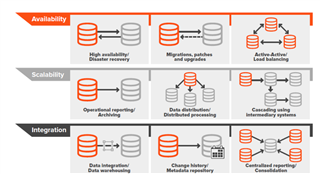We all remember Abbott and Costello’s skit “Who’s On First?”. If you haven’t seen it, I highly recommend you pop over to YouTube and give it a watch. It has become one of the legendary classic comedies of all times, with Costello not knowing baseball players’ names or positions. When it comes to comedy this is great, but when it comes to your data, not so great. In today’s world, not knowing or having control of your data will cost you money, reputation and possibly even your job. It has now become a critical part of a DBA’s life to know where their data is going and how it’s being used.
What if you had the control of being able to selectively replicate only the data that’s needed, only to where it’s needed.
What if you had the satisfaction of knowing where your data was going and only the right people were viewing it?
SharePlex puts that control and knowledge in your hands.
In today's world, your data must be agile, available AND controllable whenever and wherever it’s needed.
SharePlex puts that control and knowledge in your hands by using its near real-time data replication solution that’s easy to setup and use.
As the picture below shows, SharePlex’s use cases are broken into three main buckets: Availability, Scalability, and Integration. By mixing and matching these use cases you can cover almost any scenario that may come up, giving you the flexibility to replicate your data where and as you need.

Looking at the lower left of the picture, we have the data integration use case. It’s here that we use what we call horizontal and vertical partitioning for data control.
With some of the new data security requirements, controlling what data can go where has become critical to businesses AND a DBA’s life. If the wrong data gets seen by the wrong person, the implications can be enormous.
With horizontal partitioning, you can control what rows of a table go where. For example, if you have a Data Warehouse that has a sales tables for holding sales information across all your regions, and you have a column that specifies each region, you can use horizontal replication to make sure that each region only gets the sales for that regions and not for all regions. By controlling what rows get replicated to where you make sure that only appropriate row information is going to the appropriate people.
With vertical partitioning you can control what columns from a table get replicated. For example, if you are in health care and have a Data Warehouse that is replicating to smaller databases in a data distribution use case (which by the way SharePlex can do) and one of those smaller databases is for the lab, there is no reason the lab even needs to see a patients name or SSN. All they need is a patient’s ID number to identify whose lab work they are looking at. SharePlex’s vertical partitioning gives you the ability to do this.
These two options are just a part of how SharePlex lets you control your data. SharePlex also can also do transformations like joining 2 columns on a source to a single column on the target and it can even call a PL/SQL routine you may have that does transformations. With all this at your fingertips SharePlex puts you in the driver’s seat of controlling where your data goes and that will let you sleep better at night, which as a DBA is always the end goal.
Let’s now get back to Abbott and Costello and their “Who’s on First” skit and modernize it to fit our data control needs. It would go like this:
Costello: “I want to know the names of the baseball players.”
Abbott: “No, you don’t have a need for that information.”
Granted it does make the skit very short, but then again it would be fun to see Costello’s face when he is given “no” for an answer.
For more information on Data Replication visit shareplex.com


